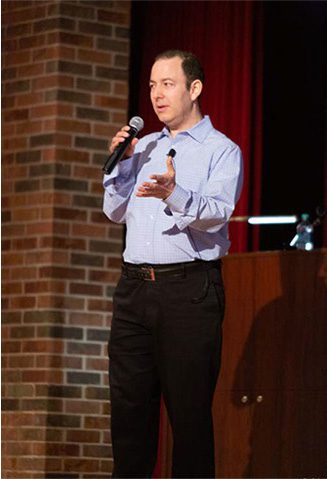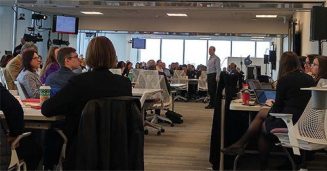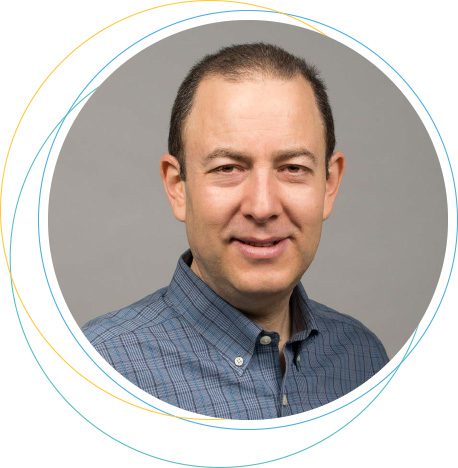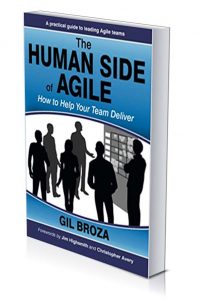
Speaking
Virtual and onsite talks

The Roadmap to Delivering Better Results
How to Unlock Your Organization’s Potential
Your organization needs to improve (perhaps even transform) its product development or solution delivery. But how? Big-bang change is risky and hard, team retrospectives have limited impact, and well-known practices and frameworks don’t always deliver the promised results.
Drawing from his experience supporting over 100 client organizations, Gil Broza has developed a novel roadmap for achieving meaningful and sustainable improvement. This non-dogmatic approach outlines a leadership foundation and 10 sequential strategies that will gradually make your whole system of value delivery more fit for purpose. These strategies are adaptable to your operating model, whether it’s product-oriented or project-oriented, agile or hybrid, single-team or scaled.
Attend this session to discover a practical model that respects human systems’ capacity for change without being philosophical, touchy-feely, or prescriptive.
Audience takeaways:
- Explain why common approaches to improving value delivery may not produce the desired results
- Describe what kind of leadership is needed to enable real, sustainable, and efficient improvement
- Discover the 10 strategies that achieve value delivery excellence in months instead of years
This presentation is for all levels of leaders in technology development.
If you’re looking to deliver better results in a healthy and sustainable way, this talk is for you!
“Gil helped the attendees understand that no matter how good their part of the business is performing, it is the output of the system as a whole that matters. Gil has a great skill in being able to translate complex system thinking theory into something everyone can digest. Recommended to any organisation wishing to make a real difference to their customers and colleagues.”
— Darren Yeates, Head of Business Agility, SITA

Get Your Mind Set on Agile
How to Achieve Better Outcomes
An Agile way of working can help you achieve better outcomes for your customers and stakeholders, and you don’t have to be in tech to benefit from it.
If you’re interested, how would you establish an Agile way of working – is it by adopting Agile practices and frameworks? by installing Agile tools? by mimicking successful software teams?
The answers are no, no, and no. The world’s been conducting a giant, uncontrolled experiment with these strategies for two decades, and they don’t work.
You’re Agile when you operate with an Agile mindset – a specific set of values, beliefs, and principles. It’s these subjective and abstract choices you and others make as you work that produce agility and improved outcomes.
Using various real-world examples, Gil will make the Agile mindset concrete and tangible, and share practical, effective strategies for adopting it.
Audience takeaways:
- Acquire helpful language for articulating the motivation for Agile
- Describe the aspects of Agile that actually matter (contrary to accepted wisdom)
- Explain what leadership needs to do to achieve real agility
This talk is for leaders and teams, both tech and non-tech.
If you’re looking to help both teams and leaders understand how having an Agile mindset is something they all can and should embrace, this talk is for you!
“Gil did a fantastic job helping attendees understand not only the importance of having an Agile mindset, but also why one is essential for any organization going through an Agile transformation. He presented the content in a relatable, interesting and thought-provoking way.”
— Director of Enterprise Agility at a financial institution

Practices Alone Won’t
Make You Agile
A Deep Dive into What Will
These days, almost every tech/IT organization has embraced Agile practices. And yet, only few have achieved real agility. Many others are experiencing a “transformation” of teams, lingo, and tools but work-wise, it’s business as usual.
Why is that? Aren’t the ingredients for effective transformations available to everyone? There is no shortage of motivation, established practices, detailed processes, ever-improving tools, literature, consultants, employees with agile experience, and certifications.
Gil Broza, author of “The Agile Mindset” and “The Human Side of Agile”, thinks that one particular ingredient continues to be overlooked in the mad rush to adopt Agile. In this session, he leads us on an exploration of that ingredient and its crucial role in successful Agile journeys.
Audience takeaways:
- Explain a powerful model for helping individuals and organizations change behaviors
- Acquire language to enable Agile transformations beyond buy-in to sprints and stories
- Describe leadership’s role in effective transformations
This presentation is for Agile practitioners and leaders.
If you’re looking to understand why your Agile transformation isn’t producing much agility – and to fix that – this talk is for you!
“Gil’s goal is to make his audience feel comfortable and equipped to take a different view on what was previously axiomatic. He succeeds.”
— Talk attendee

Your Agile Blind Spot
What’s Limiting Your Agility and What You
Can Do About It
Does your Agile implementation produce meaningful agility?
Too many well-intended implementations look fine, but they’ve really plateaued well short of their potential. They don’t produce meaningful agility: a good flow of valuable solutions to real customer problems; drama-free, affordable adaptation; and a healthy, collaborative, engaged human culture.
If you’re leading teams (directly or indirectly), or are facilitating your organization’s journey, do you know how much more Agile they can become? What could be missing, partial, or misapplied? What it would take to close the gap?
In this talk, Gil Broza reveals the seven greatest (and often invisible) weaknesses of Agile implementations, and shares workable strategies and actions for strengthening those areas.
Audience takeaways:
- Discover what’s keeping you from achieving meaningful Agility
- Recognize what needs to change and specific actions you can take
- Appreciate how popular practices, such as sprints, velocity, and backlogs, may not suffice for (and sometimes undermine) meaningful Agility
This presentation is for leaders and teams actively using Agile methods.
If you’re looking to achieve meaningful Agility, this talk is for you!
“Gil has a way of sharing knowledge that is hugely inspirational, motivating and refreshing. I truly recommend that all professionals that have a leadership role know more about Gil’s work.”
— Paula M., conference organizer, Agile Thinkers

The Best Agile Way of Working for
Your Non-Software Team
How to Avoid or Correct False Starts with Agile
“Agile” and “agility” are heard in almost every organization today. Having debuted 25 years ago, Agile ways of working have made software/IT teams more customer-focused, responsive, and productive. Nowadays, their colleagues are exploring how Agile can help them manage changing priorities and better serve their organization.
There’s one small matter though… what does it take to become agile outside of software?
Countless attempts have demonstrated that copying Agile practices from software/IT doesn’t cut it. Agile frameworks (prepackaged processes, roles, meetings, and artifacts) don’t fit perfectly either and often create false starts. And although the popular bits – task boards, sprints, standups, and demos – may seem helpful and exciting, these surface changes won’t fundamentally affect your team’s results.
Instead, the answer is to collaboratively design a way of working based on Agile values and principles. While you don’t need to be a process expert, you do need to have the right conversations with your team, management, and stakeholders. And in those conversations, empower them to make effective choices, without being tied to any prescription, tool, or so-called best practices. In this session, led by the author of “Agile for Non-Software Teams” and “The Agile Mind-Set”, to discover a practical, collaborative, empowering pathway to a way of working that supports your team’s vision and purpose.
Audience takeaways:
- Outline the steps to take and conversations to conduct for an Agile implementation that fits your vision and purpose
- Feel confident making Agile-minded choices without being tied to any prescription, tool, or so-called best practices
- Examine strategies for avoiding common pitfalls that lead to false starts, mediocrity, and bounce-backs
This presentation is for managers and leaders in non-software units (such as marketing, finance, and legal) or entire non-tech organizations.
If you’re looking to effectively achieve agility in your context, this talk is for you!
“I appreciate the message that Agile works outside of IT and outside of software development. The presentation spoke to our organization and culture which really helped me see ways I can apply Agile.”
— Talk attendee











